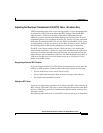
19
Release Notes for VPN Client, Release 4.0 through Release 4.0.5.D
OL-5450-10
Usage Notes
Adjusting the Maximum Transmission Unit (MTU) Value - Windows Only
VPN Encapsulation adds to the overall message length. To avoid refragmentation
of packets, the VPN Client must reduce the MTU settings. The default MTU
adjusted value is 1300 for all adapters. If the default adjustments are not
sufficient, you may experience problems sending and receiving data. To avoid
fragmented packets, you can change the MTU size, usually to a lower value than
the default. To change the MTU size, use the VPN Client SetMTU utility. If you
are using PPPoE, you may also have to set the MTU in other locations. Refer to
the following table for the specific procedures for each type of connection.
The MTU is the largest number of bytes a frame can carry, not counting the
frame's header and trailer. A frame is a single unit of transportation on the Data
Link Layer. It consists of header data, plus data that was passed down from the
Network Layer, plus (sometimes) trailer data. An Ethernet frame has an MTU of
1500 bytes, but the actual size of the frame can be up to 1526 bytes (22-byte
header, 4-byte CRC trailer).
Recognizing a Potential MTU Problem
If you can connect with the Cisco VPN Client but cannot send or receive data, this
is likely an MTU problem. Common failure indications include the following:
• You can receive data, such as mail, but not send it.
• You can send small messages (about 10 lines), but larger ones time out.
• You cannot send attachments in email.
Setting the MTU Value
If you are not experiencing a problem, do not change the MTU value. Usually, an
MTU value of 1300 works. If it doesn’t, the end user must decrease the value until
the Cisco VPN Client passes data. Decrement the MaxFrameSize value by 50 or
100 until it works.
The following table shows how to set the MTU value for each type of connection.


















